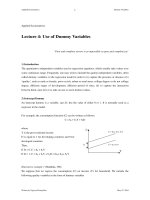Lecture Web technologies and programming – Lecture 4: Modeling web applications and implementation and testing web application - TRƯỜNG CÁN BỘ QUẢN LÝ GIÁO DỤC THÀNH PHỐ HỒ CHÍ MINH
Bạn đang xem bản rút gọn của tài liệu. Xem và tải ngay bản đầy đủ của tài liệu tại đây (411.12 KB, 20 trang )
<span class='text_page_counter'>(1)</span><div class='page_container' data-page=1></div>
<span class='text_page_counter'>(2)</span><div class='page_container' data-page=2>
2
</div>
<span class='text_page_counter'>(3)</span><div class='page_container' data-page=3></div>
<span class='text_page_counter'>(4)</span><div class='page_container' data-page=4>
• <b>Introduction to RE</b>
• <b>RE basics</b>
• <b>Requirements specification</b>
• <b>RE process</b>
• <b>RE specifics in web engineering</b>
•
<b>System modeling</b>
•
<b>Requirement Modeling</b>
– <b>use-case diagram</b>
</div>
<span class='text_page_counter'>(5)</span><div class='page_container' data-page=5>
•
<b>Requirement modeling</b>
– <b><sub>use-case diagram</sub></b>
– <b><sub>activity diagram</sub></b>
•
<b>Content modeling</b>
•
<b>Navigation modeling</b>
•
<b>Presentation modeling</b>
</div>
<span class='text_page_counter'>(6)</span><div class='page_container' data-page=6>
•
<b>The </b>
<b>information</b>
<b> provided by a web </b>
<b>application is one of the most important </b>
<b>factors for the </b>
<b>success</b>
<b> of that application</b>
•
<b>Content modeling </b>
<b>aims</b>
<b> at modeling the </b>
<b>information requirements of a web </b>
<b>application</b>
– <b>diagraming the structural and behavioral </b>
<b>aspects of the information</b>
– <b>ignores the navigational information </b>
</div>
<span class='text_page_counter'>(7)</span><div class='page_container' data-page=7>
•
<b>Key models</b>
– <b>Class diagram: to model the structural </b>
<b>aspects of information</b>
– <b>State machine diagram: to model </b>
</div>
<span class='text_page_counter'>(8)</span><div class='page_container' data-page=8>
•
<b>Class diagram describes the structure </b>
<b>of a system by</b>
– <b>system’s classes</b>
– <b>class attributes </b>
– <b>operations (methods)</b>
– <b>relationship among objects</b>
</div>
<span class='text_page_counter'>(9)</span><div class='page_container' data-page=9>
•
<b>Elements of a class diagram:</b>
•
<b>class:</b>
– <b>class is represented by a rectangle with </b>
<b>three compartments</b>
• <b>name</b>
• <b>attributes</b>
• <b>methods</b>
</div>
<span class='text_page_counter'>(10)</span><div class='page_container' data-page=10>
•
<b>Elements of a class diagram:</b>
•
<b>Adding attributes:</b>
– <b>an attribute describes a piece of </b>
<b>information that an object owns</b>
• <b>specified by name</b>
• <b>kind (data type)</b>
• <b>visibility (+, - , #)</b>
• <b>default value</b>
• <b>visibility name : type= default value</b>
– <b>+ name : string = ‘ali’ {maximum 25 characters}</b>
<b>users</b>
<b>+ name : String</b>
<b>+ email : String</b>
<b>+ password : </b>
<b>String<sub>methods</sub></b>
</div>
<span class='text_page_counter'>(11)</span><div class='page_container' data-page=11>
•
<b>Elements of a class diagram:</b>
•
<b>Adding methods </b>
<b>(functions):</b>
– <b>behaviors (things objects can do or can be </b>
<b>done with them)</b>
• <b>name</b>
• <b>arguments</b>
• <b>visibility (+, - , #)</b>
• <b>return value</b>
• <b>visibility name (argument_name:type): </b>
</div>
<span class='text_page_counter'>(12)</span><div class='page_container' data-page=12>
•
<b>Elements of a class diagram</b>
<b>:</b>
•
<b>Association </b>
– <b>relationship between classes</b>
• <b>name of relationship</b>
• <b>direction of relationship</b>
<b>person</b> <b>owns</b> <b>car</b>
</div>
<span class='text_page_counter'>(13)</span><div class='page_container' data-page=13>
•
<b>Elements of a class diagram:</b>
•
<b>Association multiplicity </b>
– <b>How many objects participating in the </b>
<b>relation</b>
</div>
<span class='text_page_counter'>(14)</span><div class='page_container' data-page=14>
•
<b>Elements of a class diagram</b>
<b>:</b>
•
<b>Aggregation relation</b>
– <b>class has features of another class plus </b>
<b>some own features</b>
</div>
<span class='text_page_counter'>(15)</span><div class='page_container' data-page=15>
•
<b>Elements of a class diagram:</b>
</div>
<span class='text_page_counter'>(16)</span><div class='page_container' data-page=16>
<b>user</b>
<b>s</b>
<b>- name : string </b>
<b>-email : string</b>
<b>-password : string</b>
<b>-register</b>
<b>-login</b>
<b>video</b>
<b>-videoID : int</b>
<b>+videoTITLE : string</b>
<b>+videoDES : string</b>
</div>
<span class='text_page_counter'>(17)</span><div class='page_container' data-page=17>
•
Use-case diagram : Conference Paper
</div>
<span class='text_page_counter'>(18)</span><div class='page_container' data-page=18>
•
<b>Conference Paper Submission System</b>
Source: Web Engineering – Kappel et al.
</div>
<span class='text_page_counter'>(19)</span><div class='page_container' data-page=19>
•
<b>Models how web-pages are</b>
<b> linked </b>
<b>together</b>
– <b>defines the structure of the hypertext</b>
• <b>Which classes of the content model can be </b>
<b>visited by navigation</b>
– <b>Content to navigation</b>
– <b> />
</div>
<span class='text_page_counter'>(20)</span><div class='page_container' data-page=20>
•
<b>UWE navigation modeling</b>
– <b>navigationClass</b>
– <b>menu</b>
– <b>Index </b>
– <b>query</b>
– <b>processClass</b>
– <b>Processlink</b>
– <b>Navigation link</b>
</div>
<!--links-->









